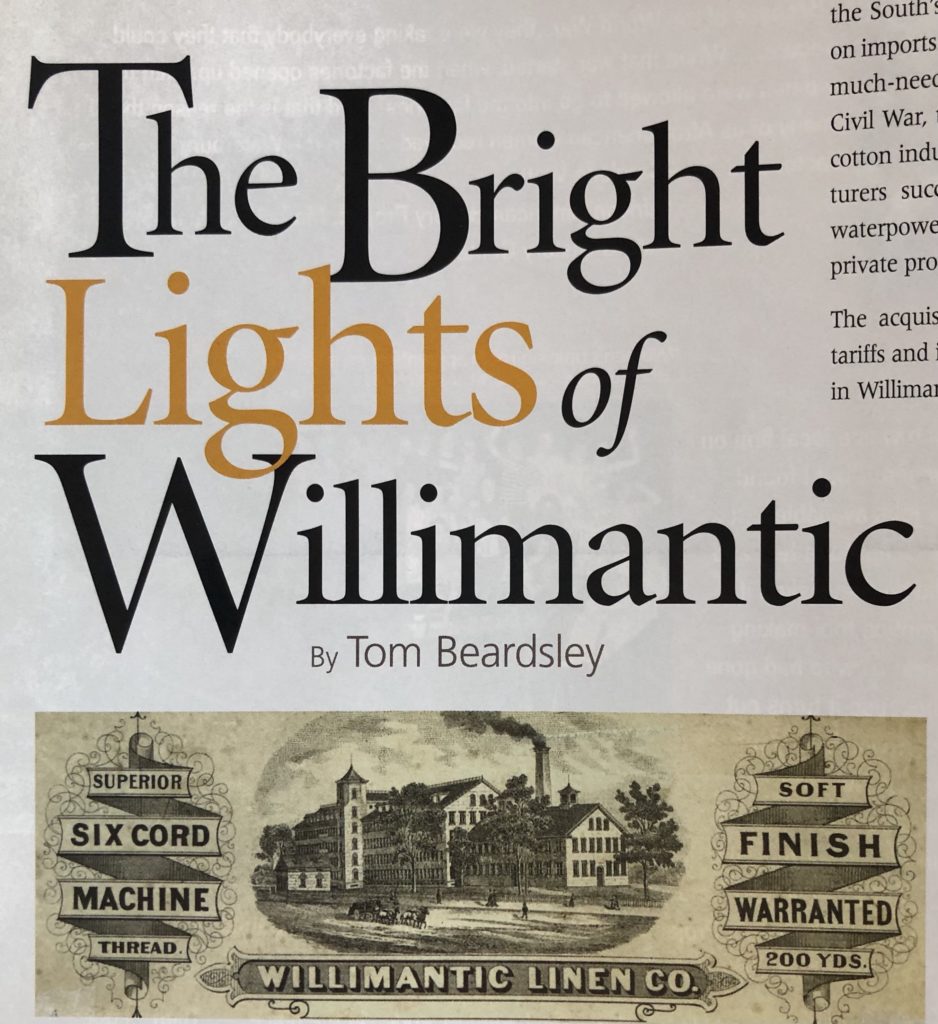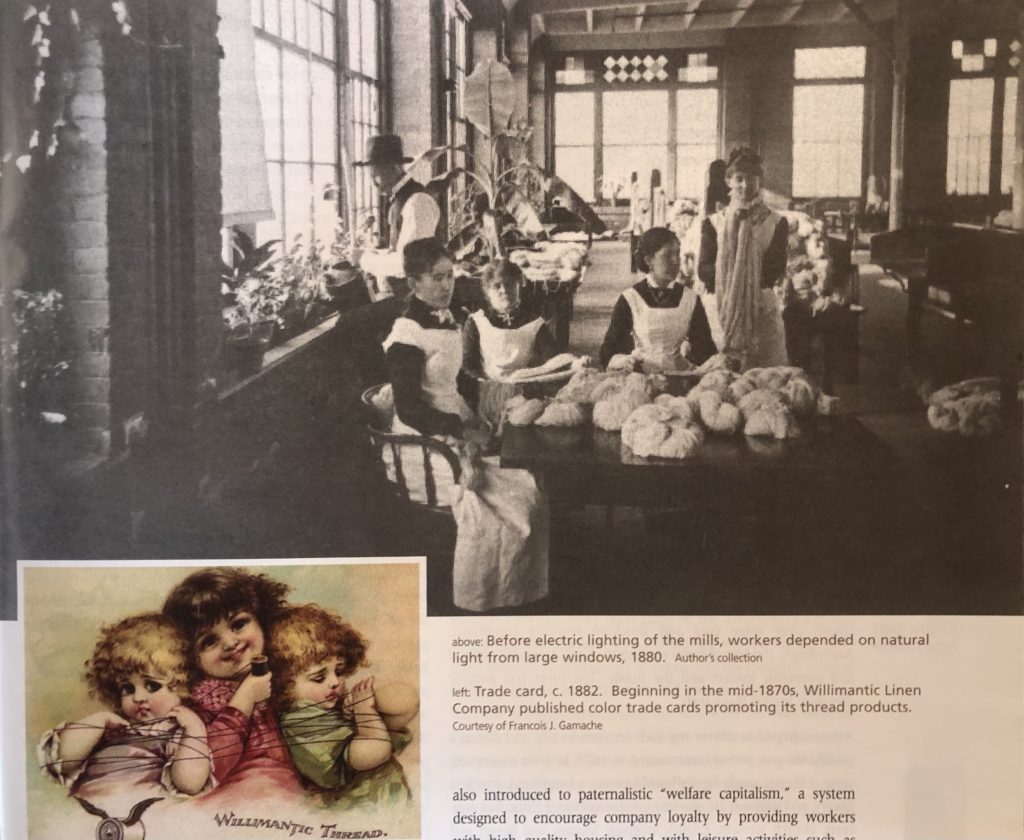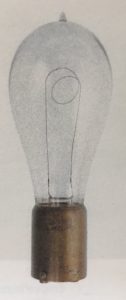
Thread box, c. 1879. The center woodcut depicts Mill Number Two, where the Willimantic Linen Company’s first experiments with the Brush electric arc light took place in 1879. The box held 12 small spools of colored cotton thread designed for use in domestic sewing machines. Courtesy of Rose Beaulieu
By Tom Beardsley FALL 2007
Subscribe/Buy the Issue!
On February 18, 1854, two prominent Connecticut manufacturers, Austin Dunham (1805-1877) and Lawson Ives (1804-1867), along with investors from New York and England, established a cotton-thread manufacturing corporation in Willimantic. They named it the Willimantic Linen Company and confidently forecast that, thanks to its new rail connection with Hartford and Providence, Willimantic would shortly be tapping into national and worldwide markets.
By 1856, the Willimantic Linen Company’s stockholders were enjoying healthy dividends, and the following year the sale of surplus stock enabled the construction at Willimantic of Connecticut’s largest cotton mill. The company subsequently tripled its output, and this “well capitalized and run” organization operated throughout the financial panic of 1857–1858.
The Panic of 1857 and the economic necessities brought about by the South’s secession in 1861 led to the re-introduction of tariffs on imports. Not only did the 1861 and 1862 Morrill Tariffs provide much-needed revenue for the federal government during the Civil War, they also provided a shot in the arm for Connecticut’s cotton industries. Moreover, Windham County’s textile manufacturers successfully lobbied for a flowage law to obtain new waterpower privileges through compulsory purchase orders of private property.
The acquisition of waterpower rights, along with protectionist tariffs and increased government orders, fired an economic boom in Willimantic. By September 1863, Civil War orders had put the Linen Company in a “flourishing condition,” and by June 1865, it had expended more than $1 million in new mills and buildings during the previous 12 months. Furthermore, a postbellum boom in railroad building laid the foundation for further economic growth at Willimantic. In 1873, the Air Line became the first direct railroad route between Boston and New York City, and it went straight through Willimantic. All of these factors made the Linen Company virtually impervious to the stock market crash of 1873. In 1880, it declared a $4 million surplus and easily resisted a vigorous takeover bid from Scotland’s Clark Cotton Company. Accordingly, the company’s satisfied shareholders had no complaints when two individuals employed some of those profits to implement a series of social and physical engineering projects in Willimantic.
When company founder and president Austin Dunham died in 1877, his talented and enigmatic son Austin Cornelius Dunham (1833-1918) took over the organization’s reins. This passionate advocate of the emerging field of electrical engineering immediately appointed the like-minded William Eliot Barrows (1842-1901), the Linen Company’s assistant treasurer, as company vice president and general manager. The Dunham and Barrows partnership heralded a period of intense creativity, and controversy, that placed the Willimantic Linen Company on national and international maps—but eventually led to one man’s downfall.
A. C. Dunham was born in Coventry, Connecticut in 1833 and graduated from Yale in 1854, the year his father founded the Willimantic Linen Company. Later he served as a director of the Aetna and Travelers Insurance Companies. On April 7, 1883, he and others founded the Hartford Electric Light Company. The experimentations Dunham undertook with William Eliot Barrows at the Willimantic Linen Mill during the previous four years made this latter undertaking possible.
W. E. Barrows was born in Hudson, Ohio. His father Elijah Barrows, a professor of sacred literature at the Western Reserve College, had deep Connecticut roots. After serving in the Civil War, Barrows took a job at the Lowell ( Massachusetts) Machine Shop in 1868. There, Barrows learned to develop machine tools, build steam locomotives, hydraulic turbines, waterwheels, power transmission systems, and work with electricity. He was also introduced to paternalistic “welfare capitalism,” a system designed to encourage company loyalty by providing workers with high quality housing and with leisure activities such as sports, plays, and concerts.

top: Before electric lighting, workers depended on natural light from large windows, 1880. Author’s collection. Below: Trade card, x. 1882. Beginning in the mid-1870s, Willimantic Linen Company published color trade cards promoting its thread products. Courtesy of Francois J. Gamache
The Willimantic Linen Company presented Barrows with a vast social laboratory for reform and social experimentation. Willimantic’s other mill workers were living in vile conditions. Though the borough authorities in 1874 forbade the keeping of swine and other sources of filth in yards close to major thoroughfares, they were reluctant to make the mill owners clean human and animal excrement from the streets of their mill housing complexes for fear that the mill owners might close the mill down and go elsewhere. Barrows, the boss of the biggest mill company in the borough, recognized that to keep his workforce healthy, he had to give them good housing and piped water. His reforms only affected his workers. Elsewhere in the borough outbreaks of cholera and dysentery continued to hit every summer.
Barrows took up his new post as civil and industrial strife racked the nation and parts of Europe. In 1877, American workers violently clashed with militiamen, Pinkerton detectives, and federal troops over wage cuts and shocking working conditions. Accordingly, the fear of social revolution shook America’s political and economic leaders and the public. The press and popular literature fuelled those fears.
Barrows hoped to diffuse any such tensions locally, and during a prolific six-year period commencing in 1877, he built a company store, a library, single-family housing units, a fairground, a park, a library, a school. He also instituted temperance clubs, free concerts, church services, English language lessons, and flower and vegetable competitions for the patrons of company housing; he also provided workers with uniforms and regular coffee breaks.
Barrows, like his boss Dunham, was also intrigued with the possibilities offered by the emerging discipline of electrical engineering. However, in 1878, as Dunham and Barrows carefully followed the progress of Charles Francis Brush’s development of an electric arc lighting system, they encountered criticisms regarding how they treated their workers.
A disgruntled employee claimed in a letter to the National American newspaper that the Linen Company’s employees existed in a state of slavery and were compelled to vote the Republican ticket or face dismissal. The writer advised that no one should buy a single spool of Willimantic thread until the Linen Company emancipated its “slaves.” Many workers, including Irish and French Canadian immigrants, resented the paternalism. The Willimantic Enterprise was not sympathetic, sarcastically commenting that “the white slavery goes grinding on” with its singing school, art lessons, reading rooms, library and the free course of lectures that the Linen Company was providing for its well-paid workers.
Amid these criticisms, Dunham and Barrows pursued their interest in new technology, by purchasing one of the first Brush electric light systems ever manufactured, and in January 1879 they had it installed in Mill Number Two. The following month, the enterprising duo invited national and state dignitaries to witness a place “where two electric lights take the place of sixty gas burners.” A Willimantic Enterprisereporter visited the mill workers under the harsh electric lights and noted how cheerfully they were dealing with their “bondage.” Nevertheless, criticisms continued, so the Willimantic Linen Company stepped up its public relations efforts.

A Brush Swan incandescent lamp with a single-loop carbon filament and the classic “goal-post” stem mounted in a bayonet base, c. 1885. This or a similar type of bulb was used in Mill Number Four after 1883. Courtesy of John Jenkins
Experiments with the Brush arc lights continued in Mill Number Two during the summer, and Dunham invited a local photographer to take pictures of the winding room’s interior under the lights. Taking their public relations campaign to the state capital, on September 17, 1879 ( Battle Flag Day, the day Veterans commemorated the Civil War Battle of Antietam), Dunham and Barrows illuminated the capitol building and the surrounding park’s fountains and grounds with two sets of their Brush electric arc lights. They enhanced the effect with mirrors and colored filters, to the delight of the 30,000 people crowded into Bushnell Park. Spectators some six miles away clearly saw the arc lamps’ vivid rays of light.
Barrows continued experimenting with new electric lighting systems, purchasing an improved version of the arc lights in December 1879. He tested them for use in a revolutionary new mill he was designing in which a state-of-the-art Corliss steam engine would power both the lighting and machines. This vast mill structure was to cover three and a half acres, and Barrows boasted that his new Mill Number Four would be the largest cotton mill in the world. He may have even been the source of a fast-spreading rumor that the mill’s engineers had to take the curvature of the earth into account during its construction!
Experimentations with the lights continued in the company’s Mills Two and Three and enabled the company to introduce a second shift in April 1880.The following September, the company staged an electric light “competition” in its almost completed Mill Number Four to showcase the difference between the arc light and a new incandescent light manufactured by Hiram Stevens Maxim’s United States Electric Light Company. The company decided to continue with the Brush arc light, possibly because Maxim was being sued by Thomas Edison for stealing his idea of filaments enclosed by a glass bulb.
Two weeks after the competition, the Linen Company held a Republican Party rally outside the immense new mill. After the speeches, Barrows pulled a switch and illuminated the mill’s Brush arc lights. A reporter witnessing the occasion noted that “the intense white light pouring forth from the windows was distinguishable a long distance and was clearly of a different order than that derived from any ordinary method of illumination.” A crowd estimated between 5,000 and 7,000 strong then crowded into the mill, with observers speculating that this was the greatest collection of people ever witnessed under one roof in the state. A 12-piece orchestra, along with the Hartford Glee Club choir, provided entertainment; at one point in the festivities, more than 400 couples were seen to be dancing at once.
At 10 p.m., the crowd ventured onto the grounds and witnessed a dramatic light show. An electric light reflected through colored glass from the far bank of the Willimantic River illuminated a 30-foot-high spray fountain outside the mill. “The beam of light was visible at every point from the bright spot from whence it emanated, the ray of electric light gradually growing broader as it crossed the river and struck the fountain, where it dissolved into all the colors of the rainbow.”
The Brush arc lights continued to illuminate the Linen Company’s mills for almost two years. However, problems arose because the arc light’s naked spark often ignited cotton particles and dust. Accordingly, in September 1882, Dunham invited Thomas Edison to demonstrate his incandescent lights, or electric light bulbs, in Mill Number Two.
The need for greater safety led Dunham and Barrows to purchase a Brush-Swan electric light system in 1883. The Brush-Swan system used incandescent bulbs powered by storage batteries. The system was introduced in the company library and store in August 1883. That was also the year that Barrows had built a park, fairgrounds and trotting track adjacent to the mills, and in October, the company lit the racetrack with the electric lights. The ensuing trotting race at the Willimantic Fairgrounds may have been one of the first sporting events performed outdoors under floodlights.
William Barrows, however, was not there to witness the electric-lit horse races. Even as he continued to bring electrical innovations along with controversial social policies to the Willimantic Linen Mills, profits slumped. The shareholders blamed Barrows, pointing to his extravagantly expensive mill, housing, parks, and programs. “The general opinion about here is that Barrows has spent more money for beauty than for practicability,” the local press reported, “ . . . and we think the Linen company needs a manager less revolutionary in his ideas.”
Barrows’s revolutionary ideas came to the attention of Chicago railway car manufacturer George Pullman, who in October 1883 hired Barrows to take charge of developing his company town at Pullman, Illinois. A. C. Dunham had provided Barrows not only with the financial wherewithal but also with his own personal expertise in the nascent technology of electrical engineering. The experiments at Willimantic gave him the knowledge and ability to establish the Hartford Electric Light Company in the year that Barrows left Willimantic for new challenges.
Tom Beardsley is adjunct professor of history at Manchester Community College.
Explore!
Read more from the Fall 2007 issue
Read more about products made or invented in Connecticut on our TOPICS page
“Site Lines: Rocky River Hydroelectric Plant,” Spring 2021
Kids’ Page: “Building Dams for Water & Electricity” Spring 2020
R G. Dun and Co. Collection, Baker Library, Harvard Business School: Windham County, Connecticut [henceforth RGD], 1: 203.
Willimantic Enterprise, October 29, 1878.
Willimantic Enterprise, December 31, 1878.
Willimantic Enterprise, January 28; February 11, 25, 1879.
Willimantic Chronicle, December 10, 1879; March 3, 1880; Willimantic Journal, May 14, 1880.
Willimantic Journal, September 24, 1880.
